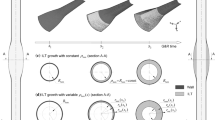Abstract
Aneurysms of the abdominal aorta enlarge until rupture occurs. We assume that this is the result of remodelling to restore wall stress. We developed a numerical model to predict aneurysm expansion based on this assumption. In addition, we obtained aneurysm geometry of 11 patients from computed tomography angiographic images to obtain patient specific calculations. The assumption of a wall stress related expansion indeed resulted in a series of local expansions, adjusting global geometry in an exponential fashion similar as in patients. Furthermore, it revealed that location of peak wall stress changed over time. The assumptions of this model are discussed in detail in this manuscript, and the implications are related to literature findings.






Similar content being viewed by others
Abbreviations
- AAA:
-
Abdominal aortic aneurysm
- CTA:
-
Computer tomography angiography
- 3D:
-
Three dimensional
- FEM:
-
Finite element methods
- MMPs:
-
Matrix metalloproteinases
References
Brady AR, Thompson SG, Fowkes FG, Greenhalgh RM, Powell JT (2004) Abdominal aortic aneurysm expansion: risk factors and time intervals for surveillance. Circulation 110:16–21. doi:10.1161/01.CIR.0000133279.07468.9F
de Putter S, Wolters BJ, Rutten MC, Breeuwer M, Gerritsen FA, van de Vosse FN (2007) Patient-specific initial wall stress in abdominal aortic aneurysms with a backward incremental method. J Biomech 40:1081–1090. doi:10.1016/j.jbiomech.2006.04.019
Fillinger MF, Marra SP, Raghavan ML, Kennedy FE (2003) Prediction of rupture risk in abdominal aortic aneurysm during observation: wall stress versus diameter. J Vasc Surg 37:724–732. doi:10.1067/mva.2003.213
Fillinger MF, Raghavan ML, Marra SP, Cronenwett JL, Kennedy FE (2002) In vivo analysis of mechanical wall stress and abdominal aortic aneurysm rupture risk. J Vasc Surg 36:589–597. doi:10.1067/mva.2002.125478
Fleming C, Whitlock EP, Beil TL, Lederle FA (2005) Screening for abdominal aortic aneurysm: a best-evidence systematic review for the U.S. Preventive Services Task Force. Ann Intern Med 142:203–211
Fridez P, Rachev A, Meister JJ, Hayashi K, Stergiopulos N (2001) Model of geometrical and smooth muscle tone adaptation of carotid artery subject to step change in pressure. Am J Physiol Heart Circ Physiol 280:H2752–H2760
Gijsen FJ, Palmen DE, van der Beek MH, van de Vosse FN, van Dongen ME, Janssen JD (1996) Analysis of the axial flow field in stenosed carotid artery bifurcation models–LDA experiments. J Biomech 29:1483–1489. doi:10.1016/0021-9290(96)84544-1
Gijsen FJ, van de Vosse FN, Janssen JD (1998) Wall shear stress in backward-facing step flow of a red blood cell suspension. Biorheology 35:263–279. doi:10.1016/S0006-355X(99)80010-9
Greenwald SE, Moore JE Jr, Rachev A, Kane TP, Meister JJ (1997) Experimental investigation of the distribution of residual strains in the artery wall. J Biomech Eng 119:438–444. doi:10.1115/1.2798291
Groenink M, Langerak SE, Vanbavel E, van der Wall EE, Mulder BJ, van der Wal AC et al (1999) The influence of aging and aortic stiffness on permanent dilation and breaking stress of the thoracic descending aorta. Cardiovasc Res 43:471–480. doi:10.1016/S0008-6363(99)00095-4
Hatakeyama T, Shigematsu H, Muto T (2001) Risk factors for rupture of abdominal aortic aneurysm based on three-dimensional study. J Vasc Surg 33:453–461. doi:10.1067/mva.2001.111731
Hirose Y, Hamada S, Takamiya M (1995) Predicting the growth of aortic aneurysms: a comparison of linear vs exponential models. Angiology 46:413–419
Li C, Xu Q (2000) Mechanical stress-initiated signal transductions in vascular smooth muscle cells. Cell Signal 12:435–445. doi:10.1016/S0898-6568(00)00096-6
Matheson LA, Maksym GN, Santerre JP, Labow RS (2006) Cyclic biaxial strain affects U937 macrophage-like morphology and enzymatic activities. J Biomed Mater Res A 76:52–62. doi:10.1002/jbm.a.30448
Newby AC (2005) Dual role of matrix metalloproteinases (matrixins) in intimal thickening and atherosclerotic plaque rupture. Physiol Rev 85:1–31. doi:10.1152/physrev.00048.2003
Schouten O, van Laanen JH, Boersma E, Vidakovic R, Feringa HH, Dunkelgrun M, Bax JJ, Koning J, van UH, Poldermans D (2006) Statins are associated with a reduced infrarenal abdominal aortic aneurysm growth. Eur J Vasc Endovasc Surg 32:21–26. doi:10.1016/j.ejvs.2005.12.024
Stergiopulos N, Vulliemoz S, Rachev A, Meister JJ, Greenwald SE (2001) Assessing the homogeneity of the elastic properties and composition of the pig aortic media. J Vasc Res 38:237–246. doi:10.1159/000051052
Takemura M, Itoh H, Sagawa N, Yura S, Korita D, Kakui K et al (2004) Cyclic mechanical stretch augments both interleukin-8 and monocyte chemotactic protein-3 production in the cultured human uterine cervical fibroblast cells. Mol Hum Reprod 10:573–580. doi:10.1093/molehr/gah077
Thompson RW, Geraghty PJ, Lee JK (2002) Abdominal aortic aneurysms: basic mechanisms and clinical implications. Curr Probl Surg 39:110–230. doi:10.1067/msg.2002.121421
Thubrikar MJ, Labrosse M, Robicsek F, Al-Soudi J, Fowler B (2001) Mechanical properties of abdominal aortic aneurysm wall. J Med Eng Technol 25:133–142. doi:10.1080/03091900110057806
van de Vosse FN, Van Steenhoven AA, Janssen JD, Reneman RS (1990) A two-dimensional numerical analysis of unsteady flow in the carotid artery bifurcation. A comparison with three-dimensional in-vitro measurements and the influence of minor stenoses. Biorheology 27:163–189
Vardulaki KA, Prevost TC, Walker NM, Day NE, Wilmink AB, Quick CR et al (1998) Growth rates and risk of rupture of abdominal aortic aneurysms. Br J Surg 85:1674–1680. doi:10.1046/j.1365-2168.1998.00946.x
Venkatasubramaniam AK, Fagan MJ, Mehta T, Mylankal KJ, Ray B, Kuhan G et al (2004) A comparative study of aortic wall stress using finite element analysis for ruptured and non-ruptured abdominal aortic aneurysms. Eur J Vasc Endovasc Surg 28:168–176
Vorp DA, Vande Geest JP (2005) Biomechanical determinants of abdominal aortic aneurysm rupture. Arterioscler Thromb Vasc Biol 25:1558–1566. doi:10.1161/01.ATV.0000174129.77391.55
Acknowledgments
This research was performed in the scope of the Hemodyn project, a cooperation between Philips Healthcare Best (Healthcare Informatics), Technische Universiteit Eindhoven (Biomedical Engineering department) and Erasmus MC (Thoraxcenter, Biomedical Engineering), Rotterdam, The Netherlands, The Hemodyn project was partly funded by SenterNovem (Dutch Ministry of Economic Affairs).
Author information
Authors and Affiliations
Corresponding author
Rights and permissions
About this article
Cite this article
Helderman, F., Manoch, I.J., Breeuwer, M. et al. A numerical model to predict abdominal aortic aneurysm expansion based on local wall stress and stiffness. Med Biol Eng Comput 46, 1121–1127 (2008). https://doi.org/10.1007/s11517-008-0358-3
Received:
Accepted:
Published:
Issue Date:
DOI: https://doi.org/10.1007/s11517-008-0358-3




